Jennette's Pier Wave Energy Test Center
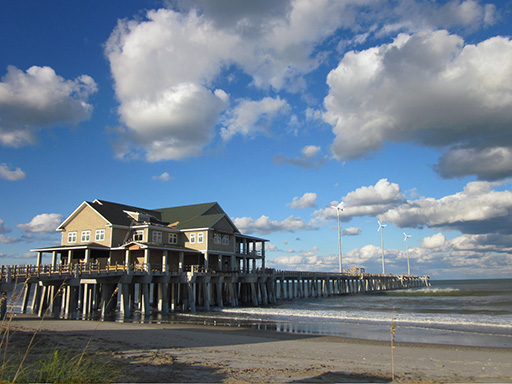
An Ideal Nearshore Testing Facility
The Jennette’s Pier Wave Energy Test Center provides a shallow water platform for testing marine hydrokinetic energy devices and device components in the open ocean off Nags Head, North Carolina. The platform also provides opportunities for public exposure and engagement since Jennette’s Pier attracts approximately 300,000 visitors annually. The Test Center is the result of a partnership between Jennette’s Pier, owned by the State of North Carolina and managed by the NC Aquarium Division, and the Coastal Studies Institute, on the East Carolina University Outer Banks Campus.
The Jennette’s Pier Wave Energy Test Center is managed by the North Carolina Renewable Ocean Energy Program and Jennette’s Pier and one of the open water test sites that are part of the Atlantic Marine Energy Center, the newest of the four US Department of Energy National Marine Renewable Energy Centers.
Testing Conditions
The Jennette’s Pier Wave Energy Test Center offers pre-permitted, non-grid-connected temporary nearshore test berths. The nearshore testing area surrounds the Pier, approximately 50 m to the north and south (average water depth of 3-6 m) of the seaward end. The offshore testing area is approximately 300 m off the seaward end of the Pier with an average water depth of 11 m. The seabed at both locations is sandy. Meteorological and ocean condition data, including wave climate, wind, and surface currents is collected nearby at the Jennette’s Pier meteorological station, a NOAA tide gauge at Jennette’s Pier (station ID 8652226), an acoustic wave and current gauge (AWAC) operated by the U.S. Army Corps of Engineers (Station JPRN7), a Waverider buoy near Oregon Inlet (operated by CSI), and three Coastal Ocean Radars that are part of the SEACOOS and NC-COOS network at Duck (maintained by U.S. Army Corps of Engineers), Buxton (maintained by UNC-Chapel Hill IMS), and Cape Lookout (maintained by CSI). UNC CSI researchers have also completed a 30-year wave hindcast that was validated by wave measurements that provides historic and predictive wave data for the area. The mean annual wave power density in the region of the test center is estimated to be 0.17 TW-hr/yr/m.
Jennette’s Pier Wave Energy Test Center most recently was proud to host the Drink stage of the National Renewable Energy Laboratory and Department of Energy’s Waves to Water Competition (add link). Resolute Marine Energy, Inc. (add link) was the first company to make use of the facility to test their Surge Wave Energy Converter in the ocean environment in 2011. Deployed from a small crane off the end of the pier, Resolute then monitored the performance of their device using equipment installed in the research operations building.
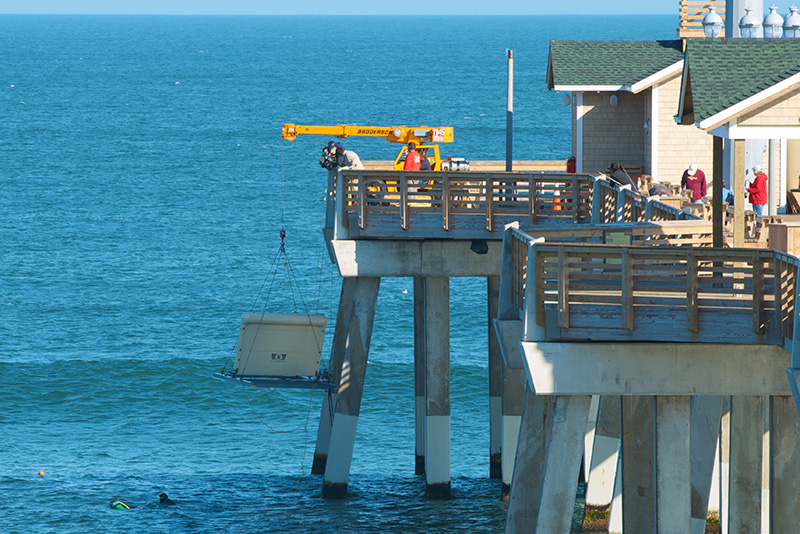
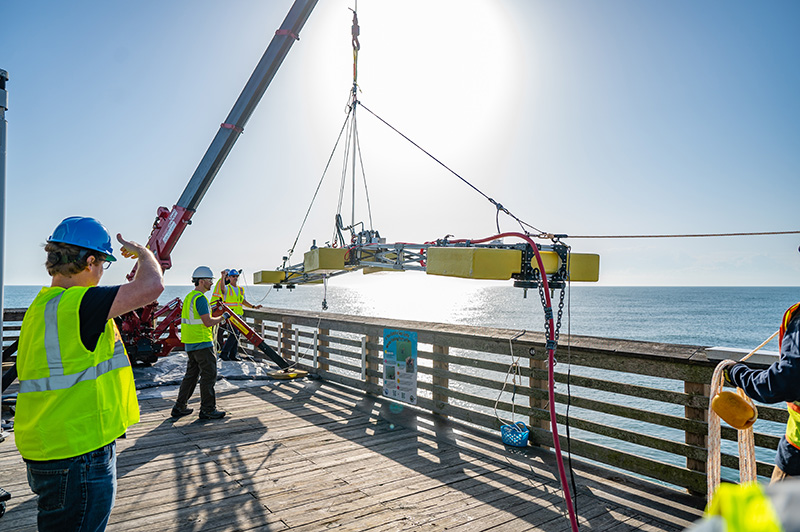
Infrastructure and Hardware
A pier house, designed to sustain category 3 hurricanes, is situated at the shoreward end of the Pier. The pier house offers fiber optic connectivity and generator back up power that will sustain experiments in the event of a power outage. UNC CSI has outfitted the pier house with a server to store and provide remote access to instrument data.
The research operations building is especially outfitted to accommodate in-situ experiments and monitoring. The climate-controlled building houses a trap door and a winch and basket system that allows researchers and divers access to the water and center pilings. The research building is also equipped with computers, which are cabled to the pier house. The pier house offers fiber optic connectivity, generator back-up power, and a server that provides remote telemetric access to instrument data
Jennette’s Pier has several renewable technologies built in to their design, including solar panels and three 10 kW wind turbines. These turbines are net metered, and while the energy does not feed into the grid, it does feed into the Pier substation. Energy generated and monitoring instrumentation will be cabled to Jennette’s Pier where there is a cable trough that protects cables running from the seabed to the research building at the seaward end of the pier and then to the pier house.
UNC CSI has the capability to monitor wave and current energy devices for their interactions with and effects on the marine environment and ecology. Two Nortek Aquadopps can be deployed in concert with devices to measure the wave and current environments in the vicinity of test devices. The unique visual and acoustic signatures generated by deployed devices, types and rates of epifaunal colonization, suspended sediment transport, and behavioral responses of marine organisms to devices can be monitored. This information is important for permit applications and may be used for the adaptive design of devices.
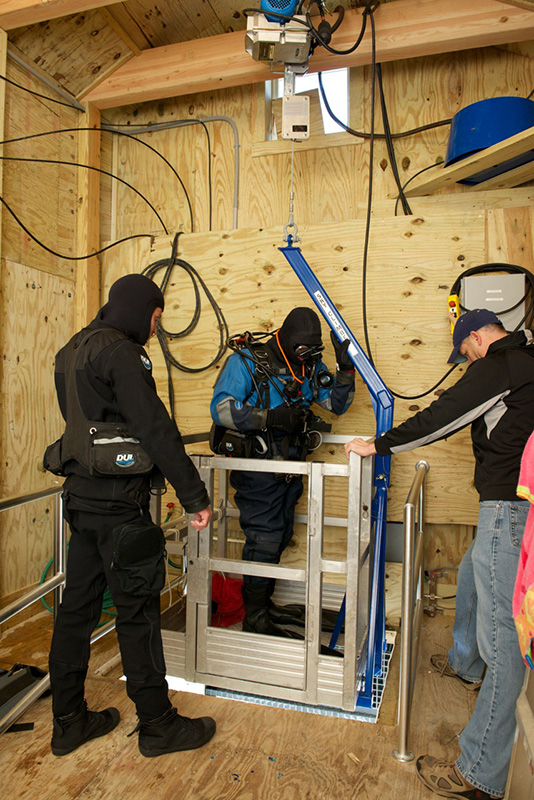
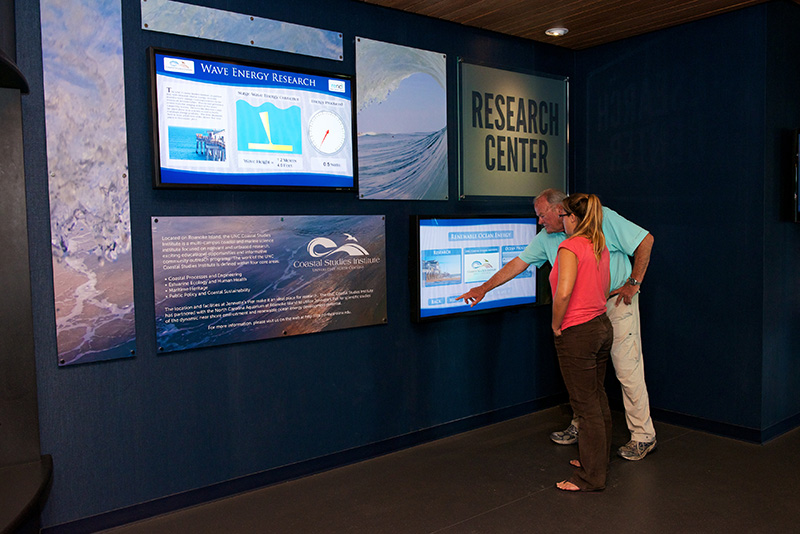
Outreach & Education
Research conducted at Jennette’s Pier provides cutting-edge content for education and outreach, and the location is excellent for opportunities to reach the public, with over 300,000 visitors passing through the pier house each year. The Coastal Studies Institute and Jennette’s Pier Wave Energy Test Center reaches these visitors via a large, interactive educational display area in the pier house called the Research Center. The Research Center displays raw and interpreted data from experiments and monitoring equipment, as well as videos of interviews with researchers and movies about research endeavors. Videos highlighting the ocean energy research and testing conducted at Jennette’s Pier are among those offered at the Research Center.
Themes from and examples of ocean energy research conducted at Jennette’s Pier are also incorporated into programs developed by the UNC-CSI outreach and education staff and Jennette’s Pier educators, including classroom and camp curricula and workshops for the public.
Contact Us
For more information about testing devices and device components at Jennette’s Pier, contact the North Carolina Renewable Ocean Energy Program Director, George Bonner.


 Based at the Coastal Studies Institute (CSI), the North Carolina Renewable Ocean Energy Program (NCROEP) advances inter-disciplinary marine energy solutions across UNC System partner colleges of engineering at NC State University, UNC Charlotte, and NC A&T University. Click on the links below for more information.
Based at the Coastal Studies Institute (CSI), the North Carolina Renewable Ocean Energy Program (NCROEP) advances inter-disciplinary marine energy solutions across UNC System partner colleges of engineering at NC State University, UNC Charlotte, and NC A&T University. Click on the links below for more information. ECU's Integrated Coastal Programs (ECU ICP) is a leader in coastal and marine research, education, and engagement. ECU ICP includes the Coastal Studies Institute, ECU's Department of Coastal Studies, and ECU Diving and Water Safety.
ECU's Integrated Coastal Programs (ECU ICP) is a leader in coastal and marine research, education, and engagement. ECU ICP includes the Coastal Studies Institute, ECU's Department of Coastal Studies, and ECU Diving and Water Safety. The ECU Outer Banks campus is home to the Coastal Studies Institute.
The ECU Outer Banks campus is home to the Coastal Studies Institute.

